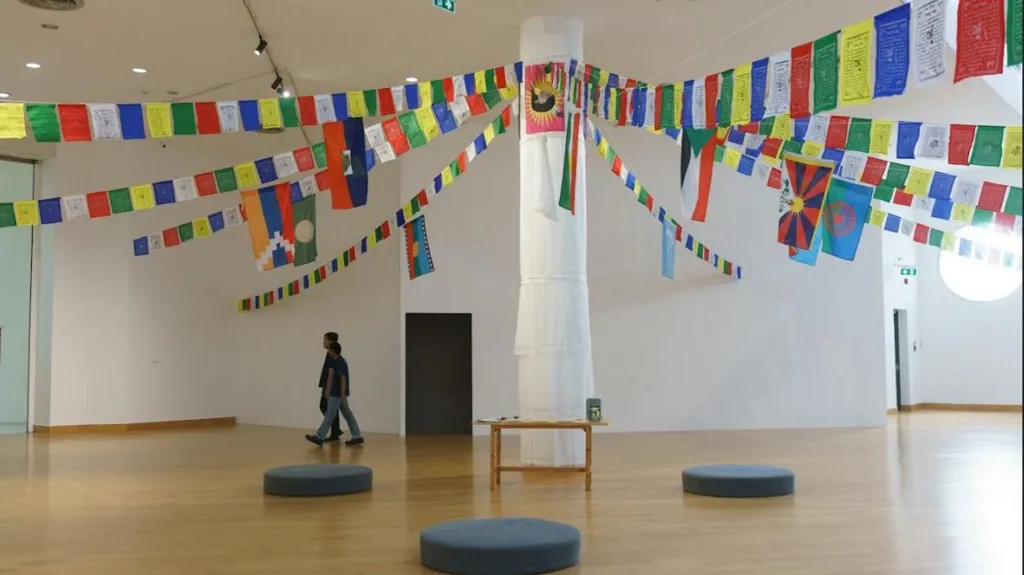An Artist on the Run, an Exhibition Censored: How China Tried to Silence a Thai Art Show
In a bold and controversial moment that captured global attention in July 2025. The Bangkok Arts and Cultural Centre (BACC) became the stage for a potent clash between artistic freedom. The exhibition, intriguingly titled “Constellation of Complicity. Visualising the Global Machinery of Authoritarian Solidarity,” was curated by Myanmar Peace Museum. The featured artists in exile exploring themes of authoritarianism, ethnic repression, and the struggle for cultural identity.
A Bold Exhibition Under Threat
Opening on July 24, 2025, the exhibition showcased powerful works from artists representing Hong Kong. The Uyghur diaspora, and other communities impacted by state suppression. Artistic expressions included video installations, flags, postcards, and multimedia commentaries on freedom and resistance. (Wikipedia, Hyperallergic)
However, just three days later, officials from the Chinese Embassy in Bangkok, accompanied by representatives from the Bangkok Metropolitan Administration. Visited the gallery and demanded it be shut down or censored. (Reuters, Wikipedia)
Forced Censorship and Erasure
Under pressure, BACC staff began obscuring or removing content deemed “problematic.” Words like “Hong Kong,” “Tibet,” and “Uyghur” were redacted. Artists’ names—including Tenzin Mingyur Paldron , Mukaddas Mijit. Hong Kong duo Clara Cheung and Gum Cheng Yee Man—were blacked out. Flags and political imagery were erased; video monitors showed empty screens where works once existed. (Reuters, Hyperallergic, Wikipedia)
Beijing Weighs In: “Distorting” Chinese Policy
China’s foreign ministry responded swiftly. It accused the exhibition of promoting “fallacies” such as “Tibetan independence,” and saying the show distorted Chinese policy. While refusing to explicitly confirm if the embassy intervened. The statement emphasized that cultural exchanges should never be used for political interference. (Reuters, Bangkok Post, BusinessWorld Online)
A Chilling Signal for Artists
In response, Sai interpreted the incident as deeply ironic. He said, calling it “a chilling signal to all exiled artists and activists in the region.” (Reuters, Wikipedia)
The Art of Resistance Persists
Despite the censorship, the exhibition remains open until October 19, 2025. The censorship amplified the show’s message. The redacted artworks and blacked-out names themselves became powerful symbols of silenced voices and erased dissent. (Khaosod English, KHAO24)
Key Takeaways
- State censorship goes global. It illustrates how authoritarian regimes now exercise cultural coercion beyond borders, targeting exiled artists and demanding suppression through diplomatic channels.
- Art becomes activism. The exhibition, initially designed to highlight authoritarian solidarit Ended up. Itself becoming a potent form of resistance—showcasing. the fragility and power of cultural expression in face of political pressure.
- Dialogue needed on sovereignty and soft power. The incident raises urgent questions: Should art spaces be off-limits to diplomatic interference? How can countries balance economic ties with protecting cultural autonomy?
SEO Highlights to Boost Discoverability
Primary keywords: Thailand art censorship, China silences exhibition, Bangkok art show censored, transnational repression, authoritarian influence, exiled artists, BACC censorship.
Secondary keywords: Sai artist on the run, Uyghur Tibetan art removal, China pressure Thailand art.
“Discover how China intervened to censor a major art exhibition in Bangkok. Forcing the removal of works by Tibetan, Uyghur, and Hong Kong artists—and politically silencing exiled voices.”




